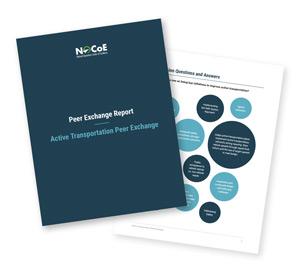Overview
This interactive discussion, hosted by the National Operations Center of Excellence and ITS America, offered an opportunity to explore select key topics of interest related to advancing Active Transportation in 2024.
Active transportation networks—including bike lanes, sidewalks, and multi-use trails—help create vibrant communities by providing safe, comfortable, convenient, reliable, efficient, and affordable ways for people to get around. The videos below features remarks from industry experts exploring topics such as: road and curb use, emerging modes and technologies, and policy needs and considerations.
Input from this forum is being leveraged to promote knowledge sharing around the state of the industry and associated challenges, needs, considerations, and future-facing opportunities.
Click here to read the Active Transportation Peer Exchange Report
Discussion Areas
- Spotlight Topic #1: Reimagining Road/Curb
- Ken McLeod, American League of Bicyclists
- Peter Koonce, City of Portland
- Spotlight Topic #2: Emerging Modes and Data Streams
- Michelle Boucher & Ian Adams, MassDOT
- Josh Cantor, GMU
- Spotlight Topic #3: State of Policy Needs/Considerations
- Judy Shanley, National Center for Mobility Management
- Randy Dittberner, P.E., PTOE, Lee Engineering
- Tim Mitchell, MnDOT
Discussion Questions and Responses
- What do you see as being key initiatives to improve active transportation? Responses
- Where can TSMO programs assist these active transportation initiatives? Responses
- What are the TSMO solutions to reimagining curb use? Responses
- How have you seen on-demand modes/services change needs and best practices? How have TSMO professionals responded to this? Responses
- Where is there room for growth/change looking forward? Responses
- Are the data approaches of operations professionals suitable for the data streams coming from emerging modes? Responses
- What are some of the current challenges/hurdles in leveraging this data or connecting it with operations data? Responses
- What do you see as being the role of the public sector vs. private sector in this space? Responses
- Looking forward, what could be done to improve awareness of existing resources, policies, and/or best practices as the industry continues to evolve? Responses
- Where do we go next with MUTCD? Responses
Next Steps
Based on the discussions during the peer exchange, NOCoE will build upon this knowledge with the following resources and activities:
- Develop an Active Transportation web portal that will incorporate these resources, additional resources from FHWA, AASHTO, NCHRP, etc. as well as the Transportation Operations Manual (TOM).
- Develop a Best Practices Report on Active Transportation and provide to TSMO practitioners.
- Notate and recommended additions or updates to the TOM.
Presentations
Reimagining Roadways - Building a Bicycle Friendly America for Everyone Ken McLeod - League of American Bicyclists | Reimagining Intersections with TSMO) Peter Koonce, P.E., Portland, OR |
MassDOT Bicycle & Pedestrian Count Program Ian Adams, Michelle Boucher - MassDOT | Active Transportation - George Mason University Josh Cantor - George Mason University |
Active Transportation Changes in the 11th Edition of the MUTCD Randy Dittberner, P.E., PTOE - Lee Engineering | Active Transportation - A Key Tenet of TSMO! Judy Shanley - National Center For Mobility Management |
The Intersection of TSMO and Active Transportation - MnDOT Experience Tim Mitchell - MnDOT | |
